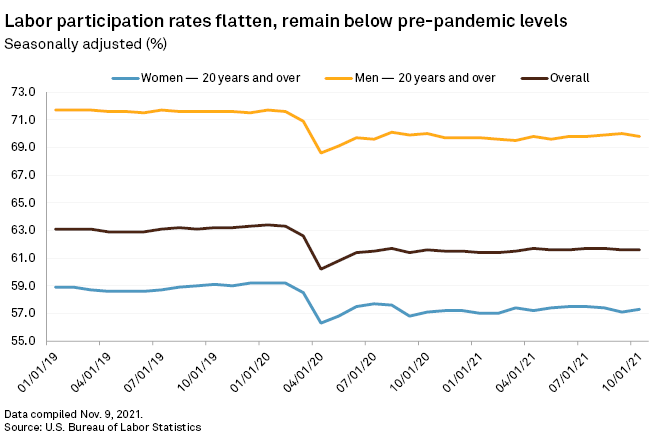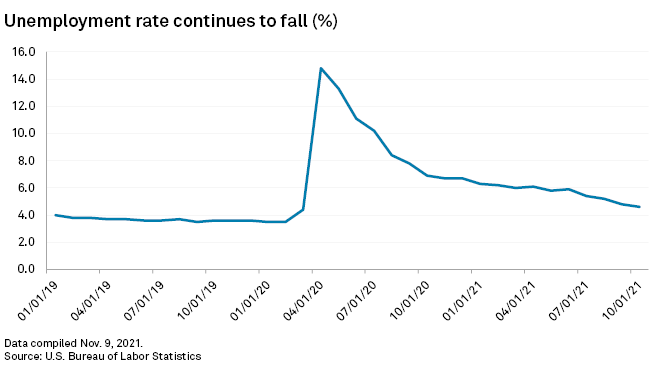Featured Topics
Featured Products
Events
S&P Global Offerings
Featured Topics
Featured Products
Events
S&P Global Offerings
Featured Topics
Featured Products
Events
S&P Global Offerings
Featured Topics
Featured Products
Events
Financial and Market intelligence
Fundamental & Alternative Datasets
Government & Defense
Banking & Capital Markets
Economy & Finance
Energy Transition & Sustainability
Technology & Innovation
Podcasts & Newsletters
Financial and Market intelligence
Fundamental & Alternative Datasets
Government & Defense
Banking & Capital Markets
Economy & Finance
Energy Transition & Sustainability
Technology & Innovation
Podcasts & Newsletters
9 Nov, 2021
Millions of Americans remain reluctant to return to work and economists do not forsee significant change anytime soon.
The U.S. unemployment rate fell to 4.6% in October, its lowest point since March 2020. But the labor participation rate — how many workers in the population are in the job market — remained at 61.6%, roughly where it has been since emerging from a pandemic low of 60.2%.
The participation rates for men and women in October remain below their pre-pandemic levels and at levels they have been at for roughly a year and a half, the latest U.S. Bureau of Labor Statistics data shows. Roughly 2.5 million fewer Americans are in the labor force since the pandemic began and many workers may not return.

"The labor force participation rate will not return to its pre-pandemic level because most of those who decided to retire early because of the pandemic will not return to the labor force," said Augustine Faucher, chief economist of The PNC Financial Services Group.
Faucher believes that ongoing health concerns about COVID-19, limited child care options, early retirements and even increased unemployment insurance benefits have contributed to the decline in the participation rates.
"I think we will see the rate gradually increase over the next year or two as the pandemic fades and people feel more comfortable working, as childcare reopens and schools fully return to in-person classes, and as people gradually spend down their accumulated savings and need to start earning income," Faucher said. "Higher wages will also pull more people into the labor force."
In a Nov. 8 interview with Fox Business, James Bullard, president and CEO of the Federal Reserve Bank of St. Louis, said the participation rate may never recover even though he said the labor market was the hottest since the end of World War II. At the end of August there were about 2 million more job openings than there were unemployed people in the U.S., according to the latest Bureau of Labor Statistics data.
"I'm not really looking for a lot of improvement on labor force participation going forward," Bullard said. "Instead, I think we're going to see downward pressure on the unemployment rate and we're going to continue to see a very hot jobs market with compensation rising."
Bullard said he expects that the U.S. unemployment rate would drop below 4% by the first quarter of 2022.

Lydia Boussour, lead U.S. economist with Oxford Economics, estimates that the participation rate will rise from its current 61.6% to 62.5% at some point in 2022. This would be 80 basis points below the 63.3% reached in February 2020.
Like Faucher, Boussour expected the combination of in-person learning, declining fears of contracting COVID-19 and vaccinations for younger children would compel more parents to return to work. However, "we don't expect participation to rise back to pre-pandemic level given the downward pull from the retirement of baby boomers," Boussour said.
Michael Pugliese, an economist with Wells Fargo Securities, said he expects workers will continue to "trickle back" to the workforce in the coming months, but the biggest gains in the labor market will likely take place in spring 2022.
"Constraints such as health concerns and unpredictable childcare should ease on the other side of the winter season, and the financial imperative to return to work should be greater with growing distance between fiscal support and the inflation gnawing away at individuals' spending power," Pugliese said. "These factors should help hiring continue at a robust pace and keep the level of employment on track to recover around the end of next year."